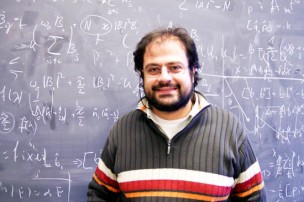
The Exley Science Center desk of Associate Professor of Physics Tsampikos Kottos is crowded. Very crowded.
But the equation-scrawled papers are about to multiply. Last June, Kottos and his colleagues at a consortium of universities across the country were awarded a $7.5 million grant from the Department of Defense to study optics, and research began in full in January.
Kottos, a theoretical physicist, works with models to understand wave transport.
“Waves are extremely important in life,” he said. “You hear me because I send waves, and you see me for exactly the same reason. Information is transferred back and forth because of waves. There are classical waves—light is a classical wave; acoustics are classical waves—but there are also other types of waves, like quantum waves and matter waves. They consist of atoms, but they obey wave equations. This is what I study.”
For the Department of Defense, Kottos and his colleagues’ eventual goal is to develop new proposals for materials in optics.
“The specific grant deals with a new type of materials, Parity-Time materials, that have strange properties,” Kottos said.
Parity-Time materials exploit losses. Losses, Kottos explained, are a reality for all physicists. Most try to minimize them, while theoretical physicists like Kottos attempt to simply discount them when solving equations. In 2010, though, Kottos and his colleagues were among the first groups to attempt to manipulate, rather than obliterate, losses.
“Our philosophy: let’s not see losses as an anathema, but actually as a friend,” he said. “Together with the gain, another element that we know how to deal with, let’s try to blend them together and create systems that can allow us, for example, to make illusions. We can design the material in a way that it has two layers, A and B. As light goes through, we are able to interrogate the light and conclude that we have A and B material. Our philosophy is, let’s create A and B materials, but manipulate the gain and loss inside the material so that the…light then comes out, but has no information about the material itself. This is called invisibility.”
Related to that research is Kottos’ work with the optical isolator, a device that allows the flow of light in one direction while blocking it in another.
“I send you light, I send you information,” he said. “But then, when the light reaches you, you can’t send it back; it’s blocked. You keep the information only for yourself. It’s good. This way, you are the collector of the information, and the rest knows nothing. It’s very good.”
Kottos, who works in the theoretical, is nonetheless compelled by potential applications.
“I draw my motivation from the applications,” he said. “This doesn’t mean I’m not excited every time I recognize new fundamental structures, which at the specific moment might not have any application, but on the other hand, I keep an eye on the application as much as I can.”
The optical isolator that Kottos and Professor of Physics Fred Ellis have proposed has existed for 30 or 40 years now. The problem is that the devices are big and bulky.
“The current trend in technology is to militarize this down to a micro-scale so we can put it on scene,” Kottos said. “This is the hard job. This is the problem we try to solve both from the fundamental perspective and from the applied one.”
The consortium of five other universities with which Kottos partners includes the University of Central Florida’s CREOL College of Optics & Photonics, Rice University, Massachusetts Institute of Technology, Georgia Institute of Technology, and University of Utah. Within the six universities, Kottos and his Wesleyan colleagues are the only theoreticians. The prototype of the optical isolator will be assembled at CREOL; the materials will be developed at Georgia Tech.
Kottos’s Wesleyan team consists of two undergraduates, two graduates, and, by the end of the summer, two post-doctorates. He is on the lookout for new undergraduates to join the project; it has been a goal of the department to offer more optics opportunities to undergraduates.
“The Physics Department is a faculty of nine people,” Kottos said. “We try hard, and succeed in many aspects, to fulfill undergrad needs. But with nine people, you can only do so much.”
When asked whether he has any ethical reservations about conducting research that has potentially violent applications, Kottos chuckled.
“We are conducting fundamental research,” he said. “It has nothing to do with dirty types of things. We are on the pure side. In this respect, there is no issue of ethical reservations, simply because all our research is publishable; nothing is under the table or under the carpet.”
He added the goal of the grant isn’t to develop one specific device.
“If, for example, we come up with an element that allows people to communicate faster, that would be great,” he said. “Telecom, or Bell Labs, would be extremely happy to have something like that coming from us. But at the end of the day, it will be developed by engineers. We are developing the prototype, the basic idea, the fundamental physics and chemistry that will help us grow these types of things. That’s as much as we’re doing.”
Theory, though, is where much of the great work lies, according to Kottos.
“At Wesleyan, we don’t have an optics laboratory,” he said. “What we have are good ideas. It’s a great satisfaction to realize that you’re among the first to realize the basics of something new. Looking into the abyss is threatening, but at the same time it’s also fulfilling because it makes you feel how small you are. We realize how many things we don’t know. That’s the definition of science.”



Leave a Reply